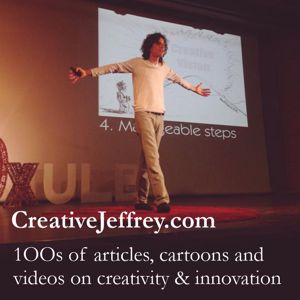Report 103
A weekly newsletter on creativity, ideas, innovation and invention.
Tuesday, 7 December 2004
Issue 45
Hello and welcome to another issue of Report 103, your weekly newsletter on Creativity, ideas, innovation and invention.
As always, if you have news about creativity, idea innovation or invention please feel free to forward it to me for potential inclusion in Report103. Your comments and feedback are also always welcome.
Information on unsubscribing, archives, reprinting articles, etc can be found
at the end of this newsletter.
WORKING WITH IDEAS THAT WON'T WORK (a very short story)
I was in the office of Maxwell Cardigan, president of Saturn Domestic Robots, demonstrating a prototype robot capable of climbing vertical surfaces in order to clean shelves, windows and that kind of thing when Max's computer chimed.
“Yes?” he called.
“Anna Schmidt is here to see you,” announced Max's secretary via the computer.
“Send her in.” said Max.
As director of research and development, I had heard of Anna. She was one of the brightest new bright sparks to join Saturn in years. Her Master's thesis on networked robot communities was brilliant and although she was still in her early days at the company, she was already impressing people. We were lucky to have snapped her up.
“Come in, Anna, come in,” said Max. “I'm so glad you were able to make it on short notice. I trust your flight was a good one.'
“Thank you, sir, I'm delighted to be here,” said Anna with a hint of a Brazilian accent.
Max introduced me to Anna and a few minutes of chit chat followed. But not many. Max never has much patience for chit chat.
“As you know, I asked you here because I was impressed with your idea about applying fractuals to the two legs walking problem.”
One of the biggest challenges facing robot engineers is getting robots to walk upright on two legs like humans do. Two legged robots can walk in straight lines easily enough. But turning corners, climbing up stairs, stepping over obstructions and running are all highly problematic, usually resulting in robots falling over. That's why household robots tend to be squat things on wheels. If we could solve the “two leg walking problem” - as it has come to be known - it would be possible to build robots that looked more human; robots like you so often used to see in science fiction films.
Every good robotic engineer has a crack at the two leg walking problem. I certainly did. No one has solved it. I had seen Anna's idea and paper on the idea management system, but knew from experience there were would be problems with her approach.
I started to voice my concerns: “It's an excellent concept, Anna, but...” I started. But Max waved me down with his hand.
“It is indeed an excellent concept, Anna,” said Max. “That's why I'm giving you three months and 150,000 Euro to see what you can do with it.”
“But,” I started. But Max's glare clearly indicated that my “but” was not wanted. So, I shut up.
Anna was, of course delighted. Max and Anna about the concept a little more and then he sent Anna off to meet some other people here at headquarters.
When she was gone, I said, “Max, what are you doing? You know fractuals won't work. I spent six months in 2022 trying to apply fractuals to walking robots. In the end, all I came up with is a solid theory showing why fractuals cannot be applied to the two legs walking problem.”
“Oh, I know,” said Max. “But you saw the passion she put into her paper. It's hard showing passion in an engineering paper, but she did so because she passionately believes in her idea, doesn't she?”
“Yes, but...”
“You say 'but' too much.”
“Yes, Max.”
“If we tell her that her first big idea will not work and prevent her from working on it, she will be seriously demotivated, won't she?” asked Max.
“Well, yes,” I answered.
“Of course she will be. And a demotivated Anna is likely to have fewer and less exciting ideas than a motivated Anna, isn't she?” said Max.
“Well, yes,” I replied.
“So at a cost of 150,000 Euro we've motivated the brightest robotics engineer you and I have seen in a long time and have essentially invested in a series of new ideas over the next year, haven't we?” asked Max.
“How can you be sure of that?” I asked in return.
“I can't. But, as I recall, during the six months you spent learning that chaos was not the solution to the two legs walking problem, you developed three new patents for the company.”
“Four, actually,” I said.
“Four, then.” Said Max. “And over the following six months you came up with a stream of new ideas that probably added a couple million to our turnover in 2022. If Anna does half as well, that 150,000 Euro is a cheap investment in our future growth.”
He did have a point. I spent six months of long days and nights in the workshop playing with fractuals and trying to apply them to the two legs walking problem. Nothing worked, but it seemed that every second or third idea I tried inspired an idea related to some other aspects of robotic motion. Fortunately, I kept a journal of those ideas. In fact, those ideas are a large part of why I am head of research and development now.
“By the way,” said Max as I was leaving his office. “I tried the fractuals approach myself while working for International Industrial Robots in the late 2010s. I spent a year on the problem without finding a solution. But no one at International Industrial Robots was interested. So, I used the ideas I had had, while working on the two legs walking problem, to build a prototype for the first Saturn domestic robot. And I generated enough interest in that prototype to launch this company. To be honest, I hadn't really expected you to find a solution either. But I knew you'd find some interesting ideas in your search. And you certainly did.”
He was right you know. But now I worry. Anna really is clever. What if she finds the solution to the two legs walking problem? Think of all the ideas we might lose!”
“WE DON'T DO THINGS THAT WAY HERE”
“We don't do things that way here,” has got to be the world's worst argument against trying out a new idea. It is also the hardest argument for someone with a new idea to counter. People who say, “we don't do things that way here,” are seldom open to counter-arguments like: “why not,” or “well, we should”.
“We don't do things that way here,” is an argument that you are most likely to hear in established organisations with strong, conservative corporate cultures. It is a phrase that grows out of an inflexible operational environment and often hints at fear of new ideas and new ways of doing things.
“We don't do things that way here,” is particularly often heard in bureaucracies. But I have also heard it said in companies big and small.
Once, while doing a project for a large organisation, I received a telephone call from one of the bureaucrats there. He told me “we don't do things that way here” with such an implied threat that I half expected to be beaten up by bureaucratic thugs in aviator glasses on my way home from their office.
I wasn't. I determinedly pushed my idea and, in the end, it was a huge success.
Indeed, the world is rich with inventions and ideas from people who went ahead with their ideas in spite of being told, “we don't do things that way here.”
However, many timid people with great ideas have doubtless had their ideas and motivation squashed by this deadly phrase. “We don't do things that way here,” soon comes to mean “we don't accept any new ideas that might upset our complacency here”
What can be done?
Ban the phrase “we don't do things that way here.” from your organisation completely. Let it be known that management will not tolerate this phrase, or any variation of it, in the work place.
Tell people that if they feel the urge to say “we don't do things that way here,” they should instead say, “how do you think we could implement that idea here?” and if anyone hears the phrase “we don't do things that way here,” they should likewise translate it to mean “your idea is seriously overdue. Let us hope it will shake things up around here and inspire more new thinking like yours.”
CHOOSING BUSINESS PARTNERS
Today, more than ever, small businesses are based on partnerships. Partnerships are a great way to bring new skills to your business activities without hiring staff. Partnerships allow you to add products and services without investing in their development. Partnerships share the risks and the rewards. Partnerships allow small companies to complete with big companies on projects. Moreover, the Internet has not only made it easier to communicate with partners around the world, it has also made it easier to find new partners.
The most creative partnerships, I have found, are opposites. And that makes sense. Creative ideas come from bringing together two seemingly unconnected concepts in a way that works. Creative partnerships likewise come from bringing together two people or small firms that have very different strengths and weaknesses.
Such partnerships can be extremely creative, even if one or both partners are not particularly creative on their own. That's because when working together, each partner brings different concepts into the partnership and bringing those concepts together results in creative new ideas.
So, when choosing business partners, choose people or firms that are different to you. If you are a creative thinker with lots of ideas, but poor organisational skills, partner with a methodical thinker who is good at getting things done. If you are an extrovert with a massive personal network of contacts who is weak on planning, partner with an introvert who loves planing things in intricate detail.
You will almost certainly be impressed with the results.
Happy thinking
Jeffrey Baumgartner




